The world is a highly visual place and good vision is critical for people to perform activities of daily living such as working, driving, caring for themselves, and caring for others. Visually impaired individuals have greater morbidity and are more likely to become depressed or feel socially isolated1-4. Eye disease is more common as people age5-8, so routine eye screening for disease is essential and should increase in frequency as a patient ages9. Routine screening results in early diagnosis, prompt treatment intervention, and prevention of visual impairment. However, as patients get older, they tend to seek eye care less regularly, right at the time in their life during which they are at greatest risk of visual impairment10,11. In addition, older patients tend to live in more rural areas, and the rural patient is even less likely to have a comprehensive eye exam within the previous year compared to their urban counterparts12,13. Rural patients face many barriers to obtaining eye care through the traditional eyecare delivery model (attending a face-to-face appointment at an eye clinic) due to several factors including distance to the clinic, need for transportation, cost for travel, and time to travel. Furthermore, since many rural areas are also medically underserved, it is conceivable that a rural elderly patient may be diagnosed with a potentially blinding ocular condition in the later stages of disease because they were unable to find a provider and obtain eye exams at the recommended interval.
The average veteran, rural or urban, is more vulnerable than the general US population for potentially blinding diseases because enrollees are older patients14, with an average age of 62, with 81.1% of enrollees greater than 50 years old14. Veteran is defined here as an individual who served in a branch of the United States Armed Forces and qualifies for health care through Veterans Affairs (VA). The geriatric (age greater than 65 years) rural and medically underserved veteran population is growing, with increasing demand for services such as eye screening and glasses15. Currently, rural veterans desiring eye care need to travel to an eye clinic (ie either ophthalmology or optometry) to receive a face-to-face exam. This eyecare delivery method poses many barriers, listed earlier, that hinder the rural veteran from seeking routine eye care, which may have deleterious effects on their vision. To address the eyecare access needs of rural veterans, the Atlanta VA Eye Clinic piloted a new program called Technology-based Eye Care Services (TECS). This case report describes the early experience (March-September 2015) of TECS.
Case report
TECS is an ophthalmology-primary care store-and-forward, asynchronous, telemedicine partnership. It is designed to improve rural veterans' access to eyecare screening for common eye diseases: cataract, glaucoma, macular degeneration, and diabetic retinopathy (if the veteran is diabetic). Eyecare screening is provided in the rural primary care clinic, in a room measuring approximately 11 m2 where an ophthalmology technician is permanently based. This room does not contain typical eye exam equipment (ie no slit lamp, no phoropter). Patients are referred to the program by onsite primary care providers or by self-referral. Technicians work up the patient by following a defined protocol. Screening questions are asked including a detailed ocular, family, and social history. Distance and near visual acuity, refractive error (need for glasses) pupil reactivity, intraocular pressure and corneal thickness are measured. Pupils are dilated with 1% tropicamide in each eye. Fundus and external photos are obtained following a validated diabetic protocol (Fig1). The information is entered into an electronic health record. A physician located remotely at the main Atlanta VA Eye Clinic interprets the information collected, develops an assessment and plan, and prescribes eyeglasses if indicated. A letter is generated for each patient, informing them of the results of their eye screening exam. Those who require follow-up are called by eye clinic staff to schedule an appointment face to face in the timeframe specified by the reading physician.
The primary care clinic locations selected for this program are 74-166 km from the Atlanta VA Eye Clinic (Fig2).
Data obtained from this program formed the basis for a quality improvement/assurance project and thus information in this article is reported according to Standards for Quality Improvement Reporting Excellence guidelines16.
Several outcome measures were tracked for the program and the results of these metrics are fully reported elsewhere17. In this case report, demographic data, access to care, and cost data are reported specifically with regard to urban, rural, and highly rural veterans. Rurality, defined by Rural Urban Commuting Area (RUCA) codes18, was based on resident zip code and classified veterans as living in urban, rural, and highly rural areas. Patients making appointments for a TECS visit at one of the three community-based outpatient clinics were identified through the VA's corporate data warehouse, a standard database structure that incorporates data from multiple data sets throughout the VA to facilitate reporting and data analysis at the enterprise level. Using this data repository, appointment and visit information as well as demographic data were obtained for each patient using Microsoft SQL Server Management Studio. Once obtained, data was analyzed using Statistical Analysis Software v9.3 (SAS Institute; http://www.sas.com).
The TECS program provided eye care to a total of 1443 patients (approximately 206 eye exams per month). For the most part these veterans tended to be older than their urban counterparts. Moreover, a higher percentage of rural and highly rural veterans were classified as homeless (Table 1).
Table 2 shows TECS utilization by RUCA category. Out of 1816 appointments made to the TECS program during this time period, 102 (5.6%) did not show ('no show rate') and 271 (14.9%) cancelled, for a total non-attendance rate of 20.5%. More than 90% of the time, veterans' appointments were scheduled within 30 days of the day the request was made. Additionally, about 33% of veterans were seen on the same day they called the clinic for an appointment. Also, 78% of patients were scheduled on the exact date they desired their appointment. The ease in scheduling appointments becomes vital as one considers that 18.2% of these older rural veterans had no record of an eye exam at any VA in the past 5 years, compared to 10.3% of the urban veterans. Additionally, almost 5% of the rural and highly rural veterans who participated in the TECS program had not had an eye exam through the VA in the past 10 years compared to 0.8% of urban veterans (Table 2).
Out of the 1443 veterans who utilized the TECS program, 560 (38.8%) were referred for further evaluation because of possible glaucoma, age-related macular degeneration, diabetic retinopathy, and/or cataracts. This proportion is higher in rural veterans (40.8%) then in urban veterans (37.5%) (Table 3).
Veterans utilizing the TECS clinics saved time and money by driving less distance to their appointment (Table 4). Not measured in these data is the benefit to veterans utilizing TECS in reduced parking costs and driving stress by not driving into the metropolis, as the negative mileage and time savings found in the sample data indicate (Table 4).
Table 5 summarizes the VA's cost per veteran, on average, to provide routine screening eye care through different care delivery models.
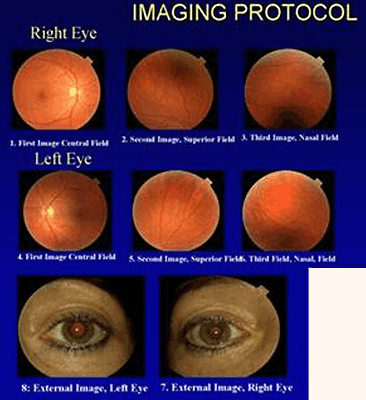
Figure 1: Fundus photography protocol.

Figure 2: The three Technology-based Eye Care Services locations (Blairsville, Newnan, and Rome) and their geographic relationship with the main Atlanta Veterans Affairs Medical Center. (Image from GoogleMaps, My Maps)
Table 1: Characteristics of veterans receiving routine eye care through Technology-based Eye Care Services (March-September 2015)
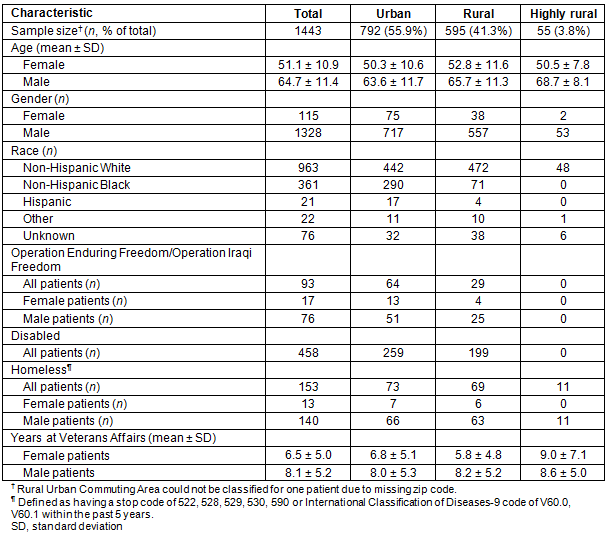
Table 2: Veterans' utilization of Technology-based Eye Care Services program by Rural Urban Commuting Area category (March-September 2015)
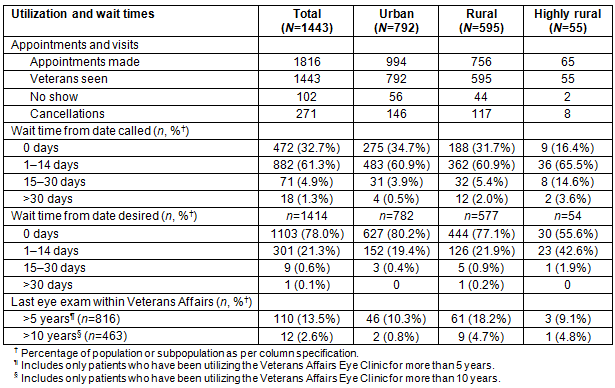
Table 3: Diagnoses resulting from Technology-based Eye Care Services visit by Rural Urban Commuting Area category (March-September 2015)
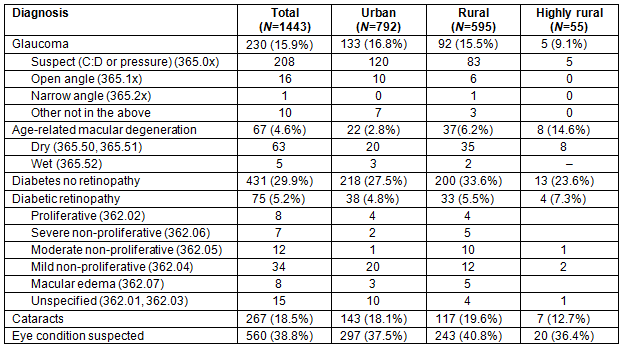
Table 4: Mileage? and cost savings for veterans utilizing the Technology-based Eye Care Services program at community-based outpatient clinic compared to receiving eye exam at Atlanta Veterans Affairs Eye Clinic (March-September 2015)
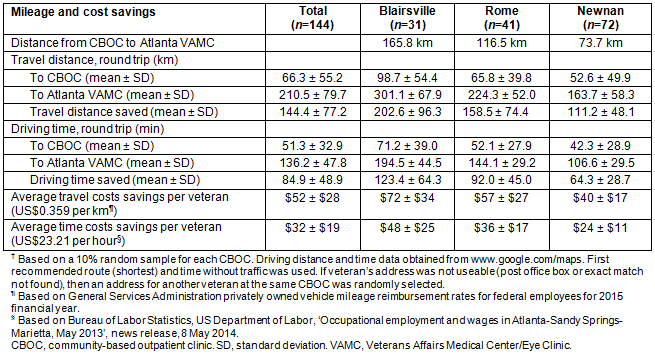
Table 5: Veterans Affairs cost per veteran to receive routine eye screening exam

TECS reduced healthcare disparities by providing care for two underserved groups: the rural and highly rural patient, and the homeless patient. Of the veterans served by TECS, a high percentage of the rural and highly rural patients were non-Hispanic white. This finding was consistent with national data where whites are more likely to live in rural areas19,20. TECS also served a proportion of homeless veterans, with the largest percentage of homeless being highly rural veterans. In addition, compared to urban patients, a higher percentage of rural veterans had been without eye care for more than 5 years. It is not surprising, therefore, that the percentage of eye disease diagnosed in rural and highly rural veterans was higher in some categories, for example, age-related macular degeneration. This is one of the most common causes of vision loss in the USA. TECS, through improving access, may help prevent blindness by identifying the disease early, which enables initiation of preventative vitamin therapy21,22.
TECS also provided specialty eye care for many homeless veterans. According to statistics of the US Census Bureau, the rate of poverty is highest in rural America23; importantly, 20.0% of highly rural patients served by TECS were classified as homeless.
One of the major goals of TECS was timely access to eye care. The data demonstrate that TECS was highly successful in giving timely access to care for all veterans entering the program. More than 90% of patients received an appointment within 14 days of their desired date, defined as the date between when the patient wanted his/her appointment and the date of the actual appointment. Also, 33% of patients received an eye appointment on the same day they called to schedule their appointment.
Finally, TECS helped mitigate the barriers of travel distance, time and cost for rural and highly rural veterans. Veterans saved, on average, 145 km of driving distance and 85 minutes of driving time by obtaining eye care at their community-based outpatient clinic instead of at the main eye clinic. This translated to savings for the VA system of approximately US$52 per patient from mileage reimbursements alone. The total non-attendance rate (no show plus cancellations) of approximately 20% in the TECS program was lower than the total non-attendance rate at the main eye clinic.
TECS is a novel remote eyecare screening initiative that was begun by the Atlanta VA Eye Clinic in an effort to improve access to routine eye care, especially for rural and highly rural veterans. In its inaugural months, TECS has successfully provided improved access to not only rural and highly rural veterans but also homeless veterans. This program has saved veterans time and money, and possibly reduced cost to the VA system - about US$200 per patient for a total of US$288,000 in less than 1 year. TECS represents a remote health innovation that may help address the visual needs of rural or disadvantaged patients by providing specialty eyecare access through the primary medical care home. It is a screening program that focuses on maintaining a patient' visual health and preventing blindness.
Acknowledgements
This material is based upon work supported by the Department of Veteran Affairs, Office of Rural Health, and the Veteran's Health Administration, Office of Rural Health. All authors have made major contributions to the success of the program. The views expressed in this article are the opinions of the authors and in no way reflect policy or opinions of the VA or the US Federal Government.
References
1. Cummings SR, Nevitt MC, Browner WS, Stone K, Fox KM, Ensrud KE, et al. Risk factors for hip fracture in white women. Study of Osteoporotic Fractures Research Group. New England Journal Medicine 1995; 332(12): 767-773. https://doi.org/10.1056/NEJM199503233321202
2. Klein BE, Klein R, Lee KE, Cruickshanks KJ. Performance-based and self-assessed measures of visual function as related to history of falls, hip fractures, and measured gait time. The Beaver Dam Eye Study. Ophthalmology 1998; 105(1): 160-164. https://doi.org/10.1016/S0161-6420(98)91911-X
3. Eichenbaum JW. Geriatric vision loss due to cataracts, macular degeneration, and glaucoma. Mount Sinai Journal Medicine 2012; 79(2): 276-294. https://doi.org/10.1002/msj.21303
4. Eichenbaum JW, Burton WB, Eichenbaum GM, Mulvihill M. The prevalence of eye disease in nursing home and non-nursing home geriatric populations. Archives Gerontology Geriatrics 1999; 28(3): 191-204. https://doi.org/10.1016/S0167-4943(99)00009-6
5. Friedman DS, O'Colmain BJ, Munoz B, Tomany SC, McCarty C, de Jong PT, et al. Prevalence of age-related macular degeneration in the United States. Archives Ophthalmology 2004; 122(4): 564-572. https://doi.org/10.1001/archopht.122.4.564
6. Friedman DS, Wolfs RC, O'Colmain BJ, Klein BE, Taylor HR, West S, et al. Prevalence of open-angle glaucoma among adults in the United States. Archives Ophthalmology 2004; 122(4): 532-538. https://doi.org/10.1001/archopht.122.4.532
7. Congdon N, Vingerling JR, Klein BE, West S, Friedman DS, Kempen J, et al. Prevalence of cataract and pseudophakia/aphakia among adults in the United States. Archives Ophthalmology 2004; 122(4): 487-494. https://doi.org/10.1001/archopht.122.4.487
8. Congdon N, O'Colmain B, Klaver CC, Klein R, Munoz B, Friedman DS, et al. Causes and prevalence of visual impairment among adults in the United States. Archives Ophthalmology 2004; 122(4): 477-485. https://doi.org/10.1001/archopht.122.4.477
9. American Academy of Ophthalmology. Comprehensive adult medical eye examinations. (Internet) 2015. Available: http://www.aao.org/preferred-practice-pattern/comprehensive-adult-medical-eye-evaluation-2015 (Accessed 10 May 2016).
10. McGwin G, Khoury R, Cross J, Owsley C. Vision impairment and eye care utilization among Americans 50 and older. Current Eye Research 2010; 35(6): 451-458. https://doi.org/10.3109/02713681003664931
11. Eye-care utilization among women aged > or =40 years with eye diseases - 19 states, 2006-2008. Morbidity Mortality Weekly Report 2010; 59(19): 588-591.
12. Kilmer G, Bynum L, Balamurugan A. Access to and use of eye care services in rural Arkansas. Journal of Rural Health 2010; 26(1): 30-35. https://doi.org/10.1111/j.1748-0361.2009.00262.x
13. Krishna S, Gillespie KN, McBride TM. Diabetes burden and access to preventive care in the rural United States. Journal of Rural Health 2010; 26(1): 3-11. https://doi.org/10.1111/j.1748-0361.2009.00259.x
14. Department of Veterans Affairs. Survey of veteran enrollees' health and reliance upon VA. Washington DC: Department of Veterans Affairs, 2011.
15. Veterans' Health Administration Service Support Centre. (Internet). Veterans Affairs internal database. (Accessed 29 March 2013).
16. Standards for Quality Improvement Reporting Excellence. SQUIRE - Standards for Quality Improvement Reporting Excellence. (Internet). Available: http://www.squire-statement.org/index.cfm?fuseaction=page.viewpage&pageid=471 (Accessed 15 December 2015).
17. Maa AY, Wojciechowski B, Hunt K, Dismuke C, Janjua R, Shyu J, et al. Experience with Technology-based Eye Care Services (TECS): a novel ophthalmologic remote care initiative. Ophthalmology 2017 (in press).
18. West AN, Lee RL, Shambaugh-Miller MD, Bair BD, Mueller KJ, Lilly RS, et al. Defining 'rural' for veterans' healthcare planning.
19. Loflin L. Rural poverty: 11 myths and realities. (Internet) 2013. Available: http://www.sullivan-county.com/nf0/dispatch/pov_myths.htm (Accessed 28 February 2016).
20. Dudenhefer P. Poverty in the rural United States. (Internet) 1980. Available: http://www.irp.wisc.edu/publications/focus/pdfs/foc151c.pdf (Accessed 28 February 2016).
21. Age-Related Eye Disease Study Research Group. A randomized, placebo-controlled, clinical trial of high-dose supplementation with vitamins C and E and beta carotene for age-related cataract and vision loss: AREDS report no. 9. Archives Ophthalmology 2001; 119(10): 1439-1452. https://doi.org/10.1001/archopht.119.10.1439
22. Age-Related Eye Disease Study Research Group, SanGiovanni JP, Chew EY, Clemons TE, Ferris FL, 3rd, Gensler G, et al. The relationship of dietary carotenoid and vitamin A, E, and C intake with age-related macular degeneration in a case-control study: AREDS report no. 22. Archives Ophthalmology 2007; 125(9): 1225-1232. https://doi.org/10.1001/archopht.125.9.1225
23. Bishop B. Poverty in Rural America. (Internet) 2010. Available: http://www.dailyyonder.com/poverty-highest-rural-america-rising-recession/2010/12/27/3098/ (Accessed 28 February 2016).
